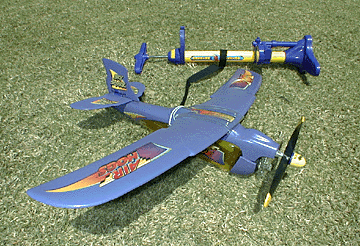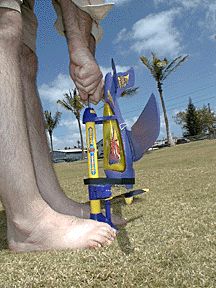


For adults, it’s
Hog heaven
The SpinMaster Air Hog
By Burl Burlingame
has become a popular toy among
the older set, despite
its $40 price tag
Star-BulletinThe first military airplanes in Hawaii were broken up in 1913 after only a few months testing. The crews decided that the winds of Hawaii were too wild and woolly for such a fragile invention.
Planes got better, but the winds are the same.
We were thinking about that while testing the SpinMaster Air Hog, a slickly designed toy that is essentially the equivalent of the good ol' rubber-band-powered model airplane, except now the power is supplied by air pressure.
The Air Hog, manufactured in Canada, is selling briskly on the continent, and goes for about $40 at retail stores such as Weller's Hobbycraft in Kailua.
Designed to be light and strong, and yet fly apart when crashing, the toy resembles a plastic shampoo bottle with dense-cell Styrofoam flying surfaces. It has stick-on markings that also help strengthen the parts. A bicycle-pump apparatus is used to fill the "bottle" with up to 90 pounds per square inch of air pressure, and an ingenious gear-and-cam arrangement releases the air in tiny bursts that spin the prop.

We took it out onto an expansive field at to test it. Glide tests were inconclusive; the pugnacious design, which looks like a Ryan Firebee, has too much drag to glide easily. Pumped up, however, the Air Hog leaps into the air, where it promptly runs into wind problems.Launched against the wind, the light design stalls. With the wind, it coasts with the flow and the wings lose lift; it drops like a pancake.
It's not easily controlled, either. There are no ailerons or rudders in the flying surfaces; bendable elevons in the horizontal controls are rather small and tend to simply nudge the plane in the proper direction.
But if the plane catches the breeze just right, it lofts to about 100 feet and flies several hundred yards. We managed to slam it into a lot of power lines, telephone poles and palm trees without damaging it too badly. Flights are unpredictable and erratic. That's part of the fun.
Apparently, more Air Hogs are sold to adults than children. Unless they're using the Houston Astrodome though, they're at the mercy of the elements.
The toy comes with an instructional videotape and a spare set of flying surfaces. Retail outlets should look into stocking spare sets of wings, which will be the first part to wear out, long before the rest of the toy. (The videotape cheerfully suggests fixing broken wings with transparent tape.) Also, the propeller, which spin at up to 4,000 rpm, can deliver a nasty bruise on fingertips that get in the way.
Given the right circumstance -- like Kona weather -- Air Hog flies like a champ. All in all, an enjoyable, clever gadget. Other toy companies are already scrambling to create knock-offs.
Click for online
calendars and events.